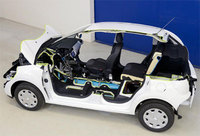Citroen Hybrid Air technology takes centre stage at Geneva Motor Show

After pioneering the diesel particulate filter system and Stop & Start; leading the way in diesel hybrid technology with Hybrid 4 and being one of the first manufacturers to market electric vehicles, Citroen continues to innovate with another high-tech breakthrough - Hybrid Air - which will be unveiled at the 83rd Geneva Motor Show this March.
A full-hybrid solution combining a petrol engine, compressed air and hydraulic power, Hybrid Air delivers exceptional performance with fuel economy in excess of 94mpg (less than 3l/100km) and no additional batteries, ensuring;
a reduced environmental footprint
more affordable pricing
no impact on cabin space
On the Citroen stand at the Geneva Motor Show, the brand will showcase a C3 VTi 82 prototype fitted with this new technology. The Citroen C3 Hybrid Air produces CO2 emissions of just 69g/km with fuel consumption reduced by a third to achieve a record-breaking 97mpg over a combined cycle. In urban driving, fuel consumption and CO2 are reduced by 45% compared with a vehicle solely fitted with the same internal combustion engine.
Innovation & Citroen DNA
The unique and revolutionary Hybrid Air system was developed by PSA Peugeot Citroen in cooperation with the Bosch Group and draws from the Citroen brand’s historic expertise of hydraulic systems for cars including;
The DS in 1955, which combined pressurised air with high pressure hydraulics to control and manage the suspension, steering, braking and semi-automatic gearbox.
A 2CV hybrid concept in 1958 that utilised pressurised air and hydraulics to boost the combustion engine. There was no real market for the car at the time and technologies were lacking for mass production, so the project never became a reality.
Hybrid Air technology in detail
Hybrid Air combines proven sub-systems and technologies including a PureTech petrol engine, a compressed air energy storage unit, a hydraulic pump/motor unit and an automatic transmission with an epicyclic gear train. Eighty patents were filed by the PSA Peugeot Citroen Group during the development process.
An intelligent electronic management system manages input from the driver to optimise energy efficiency with three operating modes;
Air power, with zero emissions
Petrol power, using just the combustion engine
Combined power, with the combustion engine and hydraulic motor working together
Hybrid Air combines all of the technologies, relying on the intelligent electronic management unit to switch continuously between the three operating modes. Optimising energy efficiency in this way cuts fuel consumption and allows the system to recharge the energy storage unit with compressed air.
Active up to 43mph (70kph), Air Mode works in the same way as the ZEV mode on existing hybrid vehicles.
The combustion engine is not used. The energy stored (compressed air) is transmitted to the wheels via the hydraulic motor and gearbox. Depending on traffic, this mode will be active between 60 and 80% of urban driving time. Maximum use of deceleration and braking energy will ensure efficient recharging of the compressed air unit.
Petrol Mode transmits energy to the wheels without input from the compressed air unit. This mode is used primarily for journeys outside urban areas. Again, the energy from deceleration and braking is recovered for use when in Air Mode or for the boost function in Combined Mode.
Combined Mode, the combustion engine and hydraulic motor work together. This mode is used particularly during pick-up and strong acceleration, with a significant boost effect (total power of up to 90 kW) delivering performance comparable to that of an engine from the next market segment.
Technology for all
Hybrid Air technology has a number of benefits that make it both attractive and economically viable for a number of global markets;
The system uses no additional batteries, so pricing will be competitive both in European and international markets
The technology operates at a constant level of efficiency, regardless of weather or driving conditions
The technology could be developed for all Citroen markets, is easily adaptable for both passenger cars and LCVs, and is particularly efficient on B & C segment models
The system has no impact on interior space or boot capacity and is essentially mechanical, which simplifies servicing operations and end-of-life recycling
The lower fuel consumption and CO2 emissions of the Hybrid Air technology also go hand-in-hand with smooth system operation for significant improvements in driving pleasure thanks to;
an automatic gearbox and epicyclic gear train with no break in torque
improved performance, with additional torque and power available in Combined Mode
a Stop & Start system using an alternator-starter
Citroen C3 Hybrid Air prototype
The Geneva Motor Show will be an opportunity for visitors to discover the C3 Hybrid Air, a new step forward in terms of ‘Créative Technologie’. Alongside the Hybrid Air technology itself, the prototype on show also features a number of specific characteristics including;
New Michelin tyres with specific sizing (165/50 R 18) that cut fuel consumption by almost 0.2l/100km and are designed with a particularly large diameter and a reduced width for lower rolling resistance, weight and noise
Specific colours and materials, with specially tinted wheels, exterior door mirror housings and headlights
The C3 prototype will also feature a ‘car scan’ function that shows all the workings of the Hybrid Air technology.



